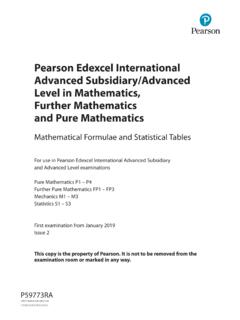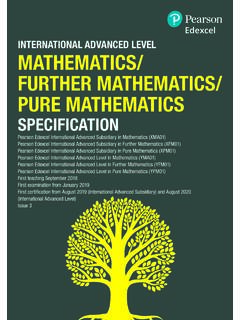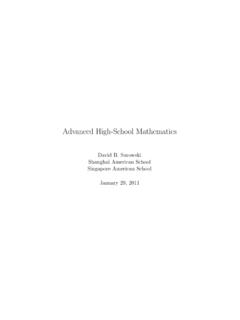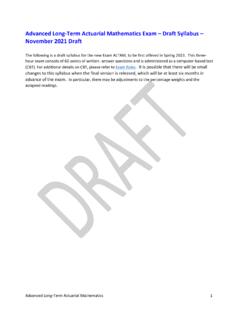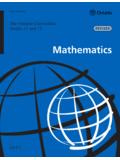Transcription of Advanced Problems in Mathematics - Colmanweb
1 Stephen Siklos Advanced Problems in Mathematics Preparing for University Advanced Problems IN. Mathematics . Advanced Problems in Mathematics : Preparing for University Stephen Siklos . c 2016 Stephen Siklos. This work is licensed under a Creative Commons Attribution International license (CC BY ). This license allows you to share, copy, distribute and transmit the work; to adapt the work and to make commercial use of the work providing attribution is made to the author (but not in any way that suggests that they endorse you or your use of the work). Attribution should include the following information: Stephen Siklos, Advanced Problems in Mathematics : Preparing for University.
2 Cambridge, UK: Open Book Publishers, 2015. Further details about CC BY licenses are available at Digital material and resources associated with this volume are available at STEP questions reproduced by kind permission of Cambridge Assessment Group Archives. This is the first volume of the OBP Series in Mathematics : ISSN 2397-1126 (Print). ISSN 2397-1134 (Online). ISBN Paperback: 9781783741427. ISBN Digital (PDF): 9781783741441. ISBN Digital ebook (epub): 9781783741458. ISBN Digital ebook (mobi): 9781783741465. DOI: Cover image: Paternoster Vents (2012). Photograph.
3 C Diane Potter. Creative Commons Attribution- NonCommercial-NoDerivs CC BY-NC-ND. All paper used by Open Book Publishers is SFI (Sustainable Forestry Initiative) and PEFC (Programme for the Endorsement of Forest Certification Schemes) Certified. Printed in the United Kingdom and United States by Lightning Source for Open Book Publishers Contents About this book ix STEP 1. Worked Problems 11. Worked problem 1 11. Worked problem 2 15. Problems 19. P1 An integer equation 19. P2 Partitions of 10 and 20 21. P3 Mathematical deduction 23. P4 Divisibility 25. P5 The modulus function 27.
4 P6 The regular Reuleaux heptagon 29. P7 Chain of equations 31. P8 Trig. equations 33. P9 Integration by substitution 35. P10 True or false 37. P11 Egyptian fractions 39. P12 Maximising with constraints 41. P13 Binomial expansion 43. P14 Sketching subsets of the plane 45. P15 More sketching subsets of the plane 47. P16 Non-linear simultaneous equations 49. P17 Inequalities 51. P18 Inequalities from cubics 53. P19 Logarithms 55. P20 Cosmological models 57. P21 Melting snowballs 59. P22 Gregory's series 61. P23 Intersection of ellipses 63. P24 Sketching x (1 x). m n 65.
5 Vi Advanced Problems in Mathematics P25 Inequalities by area estimates 67. P26 Simultaneous integral equations 69. P27 Relation between coefficients of quartic for real roots 71. P28 Fermat numbers 73. P29 Telescoping series 75. P30 Integer solutions of cubics 77. P31 The harmonic series 79. P32 Integration by substitution 81. P33 More curve sketching 83. P34 Trig sum 85. P35 Roots of a cubic equation 88. P36 Root counting 90. P37 Irrationality of e 92. P38 Discontinuous integrands 94. P39 A difficult integral 96. P40 Estimating the value of an integral 98. P41 Integrating the modulus function 100.
6 P42 Geometry 102. P43 The t substitution 104. P44 A differential-difference equation 106. P45 Lagrange's identity 108. P46 Bernoulli polynomials 110. P47 Vector geometry 112. P48 Solving a quartic 114. P49 Areas and volumes 116. P50 More curve sketching 118. P51 Spherical loaf 120. P52 Snowploughing 122. P53 Tortoise and hare 124. P54 How did the chicken cross the road? 126. P55 Hank's gold mine 128. P56 A chocolate orange 130. P57 Lorry on bend 132. P58 Fielding 134. P59 Equilibrium of rod of non-uniform density 136. P60 Newton's cradle 138. P61 Kinematics of rotating target 140.
7 P62 Particle on wedge 142. P63 Sphere on step 144. Stephen Siklos vii P64 Elastic band on cylinder 146. P65 A knock-out tournament 148. P66 Harry the calculating horse 150. P67 PIN guessing 152. P68 Breaking plates 154. P69 Lottery 156. P70 Bodies in the fridge 158. P71 Choosing keys 160. P72 Commuting by train 162. P73 Collecting voles 164. P74 Breaking a stick 166. P75 Random quadratics 168. Syllabus 170. About this book This book has two aims. The general aim is to help bridge the gap between school and university Mathematics . You might wonder why such a gap exists.
8 The reason is that Mathematics is taught at school for various purposes: to improve numeracy; to hone problem-solving skills; as a service for students going on to study subjects that require some mathematical skills (economics, biology, engineering, chemistry the list is long); and, finally, to provide a foundation for the small number of students who will continue to a specialist Mathematics degree. It is a very rare school that can achieve all this, and almost inevitably the course is least successful for its smallest constituency, the real mathematicians. The more specific aim is to help you to prepare for STEP or other examinations required for uni- versity entrance in Mathematics .
9 To find out more about STEP, read the next section. It used to be said that Mathematics and cricket were not spectator sports; and this is still true of math- ematics. To progress as a mathematician, you have to strengthen your mathematical muscles. It is not enough just to read books or attend lectures. You have to work on Problems yourself. One way of achieving the first of the aims set out above is to work on the second, and that is how this book is structured. It consists almost entirely of Problems for you to work on. The Problems are all based on STEP questions.
10 I chose the questions either because they are nice' . in the sense that you should get a lot of pleasure from tackling them (I did), or because I felt I had something interesting to say about them. The first two Problems (the worked Problems ') are in a stream of consciousness format. They are in- tended to give you an idea how a trained mathematician would think when tackling them. This ap- proach is much too long-winded to sustain for the remainder of the book, but it should help you to see what sort of questions you should be asking yourself as you work on the later Problems .

